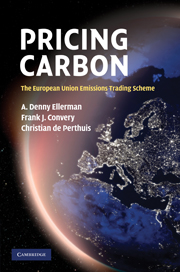Book contents
- Frontmatter
- Contents
- List of figures
- List of tables
- List of boxes
- List of appendices
- Frequently used abbreviations
- Preface
- 1 Introduction
- 2 Origins and development of the EU ETS
- 3 Allowance allocation
- 4 Effects of free allocation
- 5 Market development
- 6 Emissions abatement
- 7 Industrial competitiveness
- 8 Costs
- 9 Linkage and global implications
- 10 Conclusions
- Annex: The interaction between the EU ETS and European electricity markets
- Appendix A Sequence of events in the development of the EU ETS and Linking Directives
- Appendix B Data tables
- Bibliography
- Index
10 - Conclusions
Published online by Cambridge University Press: 05 July 2011
- Frontmatter
- Contents
- List of figures
- List of tables
- List of boxes
- List of appendices
- Frequently used abbreviations
- Preface
- 1 Introduction
- 2 Origins and development of the EU ETS
- 3 Allowance allocation
- 4 Effects of free allocation
- 5 Market development
- 6 Emissions abatement
- 7 Industrial competitiveness
- 8 Costs
- 9 Linkage and global implications
- 10 Conclusions
- Annex: The interaction between the EU ETS and European electricity markets
- Appendix A Sequence of events in the development of the EU ETS and Linking Directives
- Appendix B Data tables
- Bibliography
- Index
Summary
Doubt is an uncomfortable position; certainty is absurd.
VoltaireWhile conclusions ought not to be riddled with doubt, definitive judgements on the EU ETS seem out of place, given that the first trading period offers only three years of experience and observations. Policy is often formed on less, however, and the absurdity of certainty can apply to both sides of any proposition. Thus, we hope that the reader will share the discomfort, and appreciate the tentativeness, with which the following conclusions are proposed.
CO2 emissions are no longer free
The importance of this conclusion rests not in the price, which ranged from a few cents to more than €30, but in the changes in institutions and thinking that have characterized the trial period of the EU ETS. From being seen as a quixotic and, for some, dubious initiative, the EU ETS has become an accepted fact and centrepiece of European Union climate policy. More importantly, the fact that greenhouse gas emissions have a price has become embedded in the thinking and, more particularly, in the decision-making process for production and investment affecting the sources of more than a half of European CO2 emissions.
When emissions trading was first formally suggested by the European Commission in May 1999, the European Community comprised fifteen member states with a very diverse set of policies and inclinations regarding climate policy, not to mention attitudes towards the idea of mobilizing markets to address climate change.
- Type
- Chapter
- Information
- Pricing CarbonThe European Union Emissions Trading Scheme, pp. 287 - 292Publisher: Cambridge University PressPrint publication year: 2010



